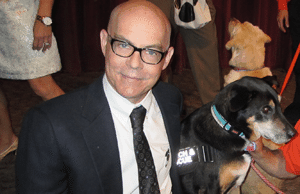UAMS Enlists Search Dogs for Cancer Study
May 30, 2012 | In the first study of its kind, Alexander “Sandy” Burnett, M.D., at the University of Arkansas for Medical Sciences (UAMS), is testing whether local search and rescue dogs can detect ovarian cancer. Ovarian cancer is often called the silent killer because the disease frequently progresses to advanced stages before symptoms appear, and there is no early detection screening. Ovarian cancer is the ninth most common cancer among women and the fifth leading cause of cancer-related death among women – the deadliest of gynecologic cancers. If dogs can be trained to reliably detect ovarian cancer, it would represent the first effective screening tool for the disease. Burnett, a gynecologic oncologist who was joined by representatives of the Arkansas Search Dog Association (ASDA), recently provided an update on the study to the Cancer Friends luncheon group at Pulaski Heights United Methodist Church in Little Rock. Four dogs from the search dog team have been imprinted on the scent and in early tests have shown the ability to distinguish between cancerous and noncancerous ovaries and urine. “Right away, the dogs hit it every time,” Burnett said. “To me, it was far beyond what my expectations were when we started this.” The study is in a pilot phase, allowing Burnett and the volunteer ASDA dog handlers to build upon their promising early results and apply for grants necessary to continue the screening study. The pilot portion of the study is expected to be completed in about six months. After that, the study will move to more complex trials to determine and document the dogs’ accuracy. Ultimately, he said, the cost of advanced screening trials with large populations of women will cost tens of millions of dollars. Researchers around the world have found that dogs can detect cancers such as melanoma, lung cancer, breast cancer, colon and rectal cancer and kidney cancer, but there has been no large-scale study. One of the limiting factors for advancing those studies, Burnett said, is that most have relied upon only one or two dogs, while the UAMS study will use six to eight dogs. “The animals are available to be quickly and easily trained by these trainers,” Burnett said. “Once a dog is trained, it can work 10-12 years, so you could potentially have an employee for 10-12 years.” The ASDA is a nonprofit group based in central Arkansas and is made up entirely of volunteers. Donna Waugh, president of the ASDA, said dogs are uniquely equipped to detect cancer. A dog’s ability to detect and distinguish scents is far more advanced than any available technology. “In a search, our dogs know how to pinpoint the odor of one person from among thousands of people, and they have assisted in the location of unmarked gravesites that are more than 100 years old,” Waugh said. “I’m confident that our dogs will show that they can reliably detect ovarian cancer.” |

